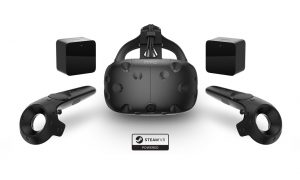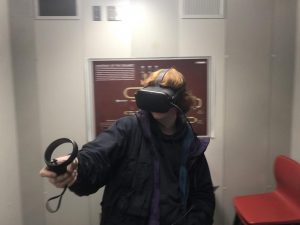The Oculus Quest Sets the Standard for the Future of Virtual Reality

Years ago, I was browsing at the Mall of America in Minneapolis, Minnesota, when I came across a demo of a new virtual reality headset, the HTC Vive, inside the Microsoft outlet store. Having never tried virtual reality, I hopped in line for a turn with the headset. After waiting for half an hour, I had my chance, and was immediately hooked. I played through a set of three experiences, one in which a whale swam over me, another where I drew in a three-dimensional space, and another where I shot at flying robots. All the while, my mind was completely exploding, and I knew the second that I took it off that I had to get one for myself. The HTC Vive cost around $1000 dollars, and required an expensive gaming computer to run. That was a no go for thirteen year-old me.

Then, when I heard that my friend had gotten the PSVR for his PlayStation, I jumped at the chance to get to try it. This time around, I enjoyed the experience even more than before, though I felt restrained by the cord that connected the headset to the PlayStation. Nevertheless, I sat for fifteen minutes in a game menu simply hitting a little ball that flew around when you hit it. The PSVR was only $250, but you needed a $400 PlayStation to use it, something I did not have. Once again, I was blocked by my lack of money and technology. I, along with many others, had tried the worst kind of virtual reality, the Google Cardboard, which you stick your phone into and hold up to your face, allowing you to look around. Although it provides the viewer with a few minutes of entertainment, you can only look around, as you are just experiencing what is basically a three-dimensional video. It lacked what I found most interesting about virtual reality, the ability to move around in, and interact with, a truly virtual world.
When I saw the announcement of the Oculus Quest, I originally ignored it, having mostly given up any hopes of owning my own virtual reality headset, but when I saw an ad for the Quest on TV, marketed as the first standalone virtual reality headset with the same abilities as a computer-powered headset, I knew I had to check it out. Sure enough, the Quest, made by Facebook-owned virtual reality company Oculus, delivered on its promise to make true VR available to the masses. The Quest features inside-out tracking, which means that all tracking of controllers and movement is done inside the headset, as opposed to having to set up sensors to track you. The Quest is also completely self powered, as it uses a three year-old smartphone processor to drive all of its functions. On top of that, it was only $400 which is still spendy, but amazingly inexpensive compared to its alternatives.
I watched many a YouTube video reviewing the Oculus Quest and its features, making sure that it was legit, as most first-generation technology is incredibly buggy, glitchy, and all around disappointing. However, no matter where I looked, I could only find stellar reviews of the device. People were genuinely pleased by the quality of the device that Oculus produced. I eventually decided that I had to get one; the prospect of such easily accessible virtual reality was simply too enticing to me. My only problem was that I was dead broke, I had spent my money on other things.

I happened to have the good fortune to receive one of these headsets for Christmas, and I was overjoyed. I set up the Quest in about fifteen minutes, and then everything else was done on the headset. I spent fifteen minutes sitting on the floor hitting a ping pong ball across a virtual room and flying a tiny blimp around. I knew from the second I was in that it was the future of virtual reality. The ease with which I was able to enter the virtual world after having not done any VR for at least a year was incredible. The operating system is very user-friendly, and makes any function easy to even the most inexperienced individual. It is for reasons such as these that the Oculus Quest is the perfect example for what the future of virtual reality should look like. Easy operating system, no expensive computers or consoles to use it, no cords to speak of, and a low price to cap it all off. In addition, Oculus released a hand tracking update that allow users to use their hands to interact with the Quest home and some apps.

One feature that I hadn’t realized that I would be using is the portability of the device. I can bring the Quest to my friend’s houses to show them the device, and to play it when I’m not at my house. Since it doesn’t need a gaming computer to use, you can bring the Quest wherever you want, and play it wherever you please. This might possibly be the best feature of the device, as it truly makes it so that you can show the device to your friends and family, and its play-space isn’t limited to your house. Its portability is also an excellent marketing move on Oculus’s part, as it almost gets free advertising when people who own the device can bring it with them to show off to others. I would highly recommend the Oculus Quest to anyone looking to explore virtual reality, or anyone who wants to have the portability of an untethered headset.
When Oculus released the Quest at one of their conferences in May of 2019, they also released a PC powered headset, called the Rift S. This was marketed as a step up from the Quest, with slightly better graphics, refresh rates, and inside-out tracking, but still used the same controllers that Quest used. However, in December, Oculus announced Oculus Link, which allows Quest owners to connect to a gaming computer through a fiber optic cable. This allows the Quest to function almost identically to the Rift S, as the refresh rate increases, and the user now has access to an immense library of games and apps. By introducing Oculus Link, the tech company has effectively done two things:
- They’ve fixed my only two complaints of the Quest by making more games accessible, and by making the display smoother.
- They’ve rendered the Rift S completely obsolete.
Oculus seemed to have released the Rift S and then forgotten about it, as almost all updates they’ve released have been upgrades to the Quest. By giving the Quest the same abilities as a computer-powered headset, along with the option to go completely wireless and portable, Oculus has made the future of virtual reality.

Hi, I'm Liam, and I'm a reporter for the Lance! I'm in my Senior year, and I love photography, nature, and anything with music. I also co-host the Lance's...




